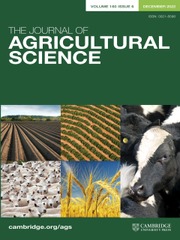No CrossRef data available.
Article contents
Agroclimatic and spectral regionalization for soybean in different agricultural settings in the state of Paraná, Brazil
Published online by Cambridge University Press: 21 November 2024
Abstract
Information related to the climate, sowing time, harvest, and crop development is essential for defining appropriate strategies for agricultural activities, which helps both producers and responsible bodies. Paraná, the second largest soybean producer in Brazil, has high climatic variability, which greatly influences planting, harvesting, and crop productivity periods. Therefore, the objective of this study was to regionalize the state of Paraná, considering decennial metrics associated with climate variables and the enhanced vegetation index (EVI) during the soybean cycle. Individual and global analyses of these metrics were conducted performed using multivariate techniques. These analyses were carried out in agricultural scenarios with low, medium, and high precipitation, corresponding to harvest years 2011/2012, 2013/2014, and 2015/2016, respectively. The results obtained from the scores of the retained factors and the cluster analysis were the profile of the groups, with Group 1 presenting more favourable climatic and agronomic conditions for the development of soybean crops for the three harvest years. The opposite occurred for Groups 2 (2011/2012 and 2013/2014) and Group 3 (2015/2016). During the soybean reproductive phases (R2 – R5), precipitation values were inadequate, especially for Group 2 (2011/2012 and 2013/2014) with high water deficit, resulting in a drop in soybean productivity. The climatic and agronomic regionalization of Paraná made it possible to identify the regions most suitable for growing soybeans, the effect of climatic conditions on phenological stages, and the variability of soybean productivity in the three harvest years.
- Type
- Climate Change and Agriculture Research Paper
- Information
- Copyright
- Copyright © The Author(s), 2024. Published by Cambridge University Press



